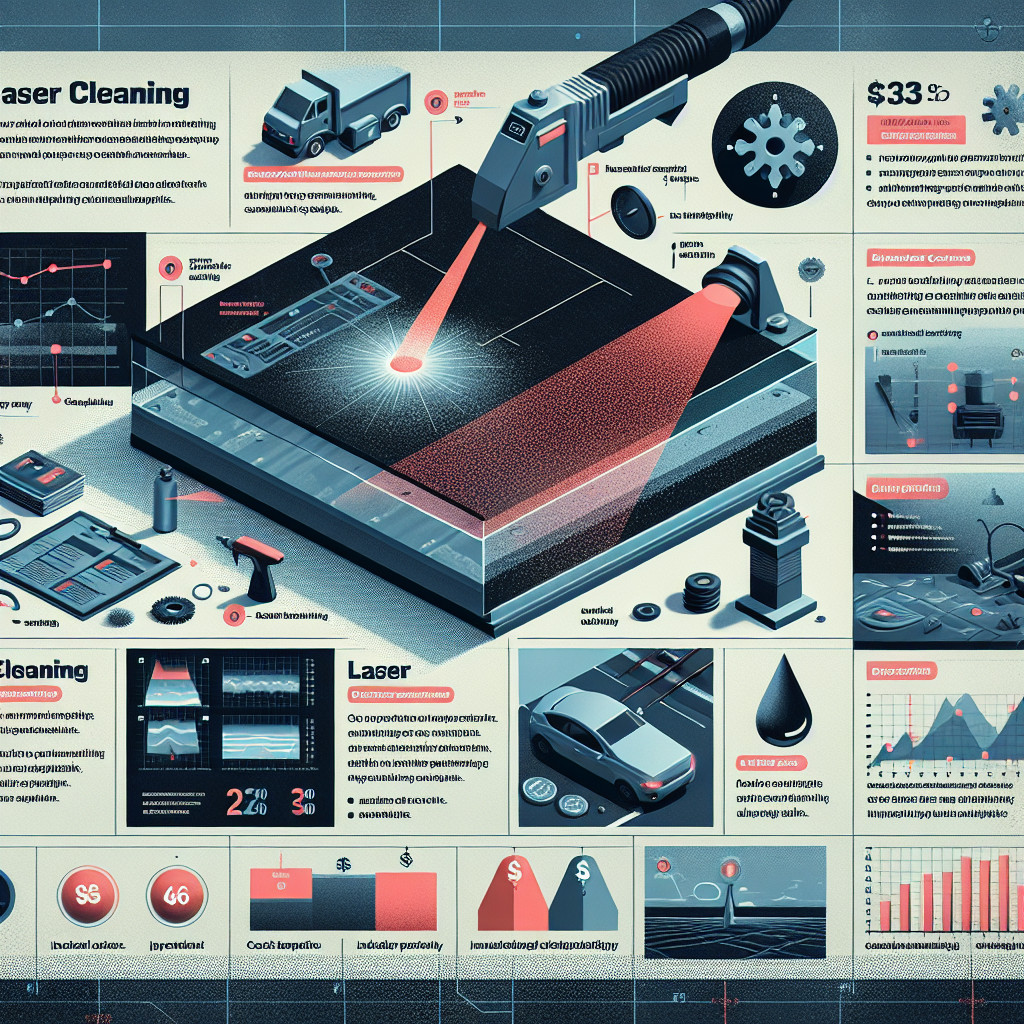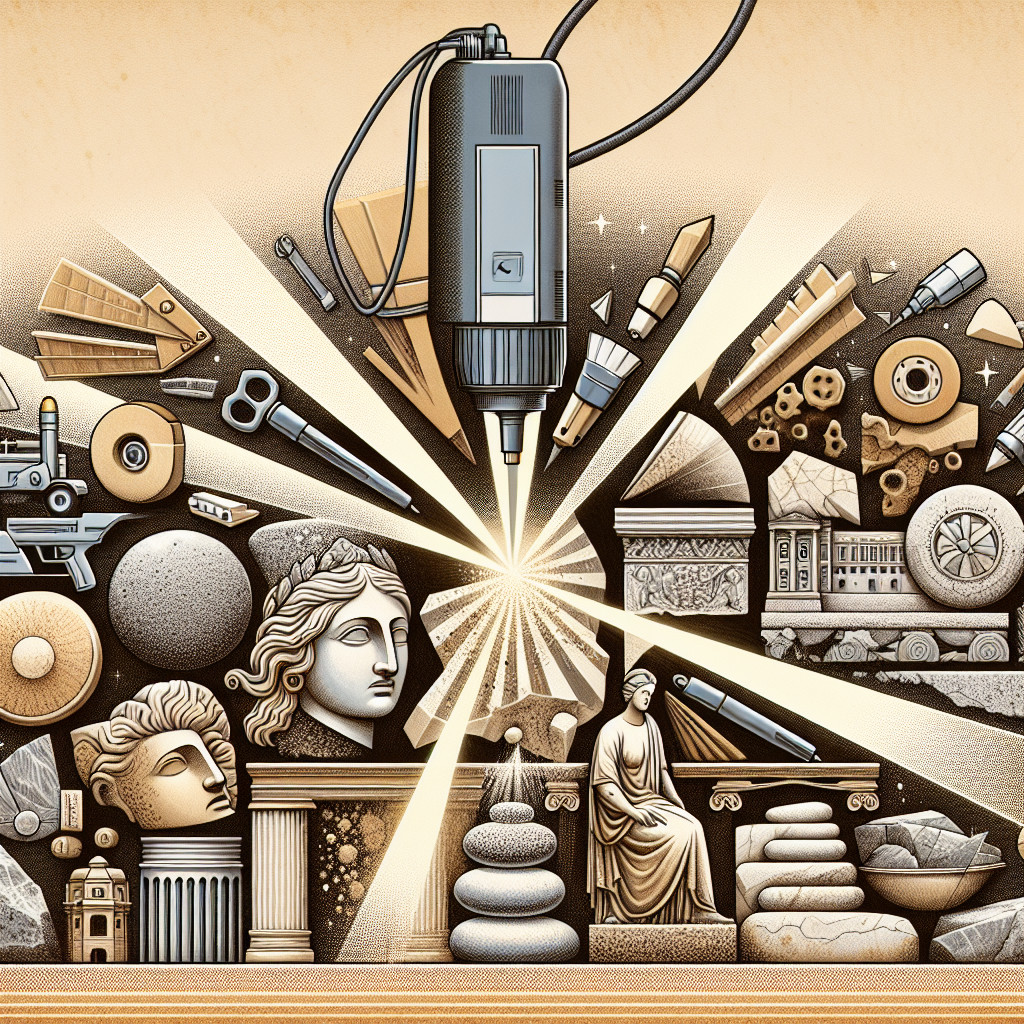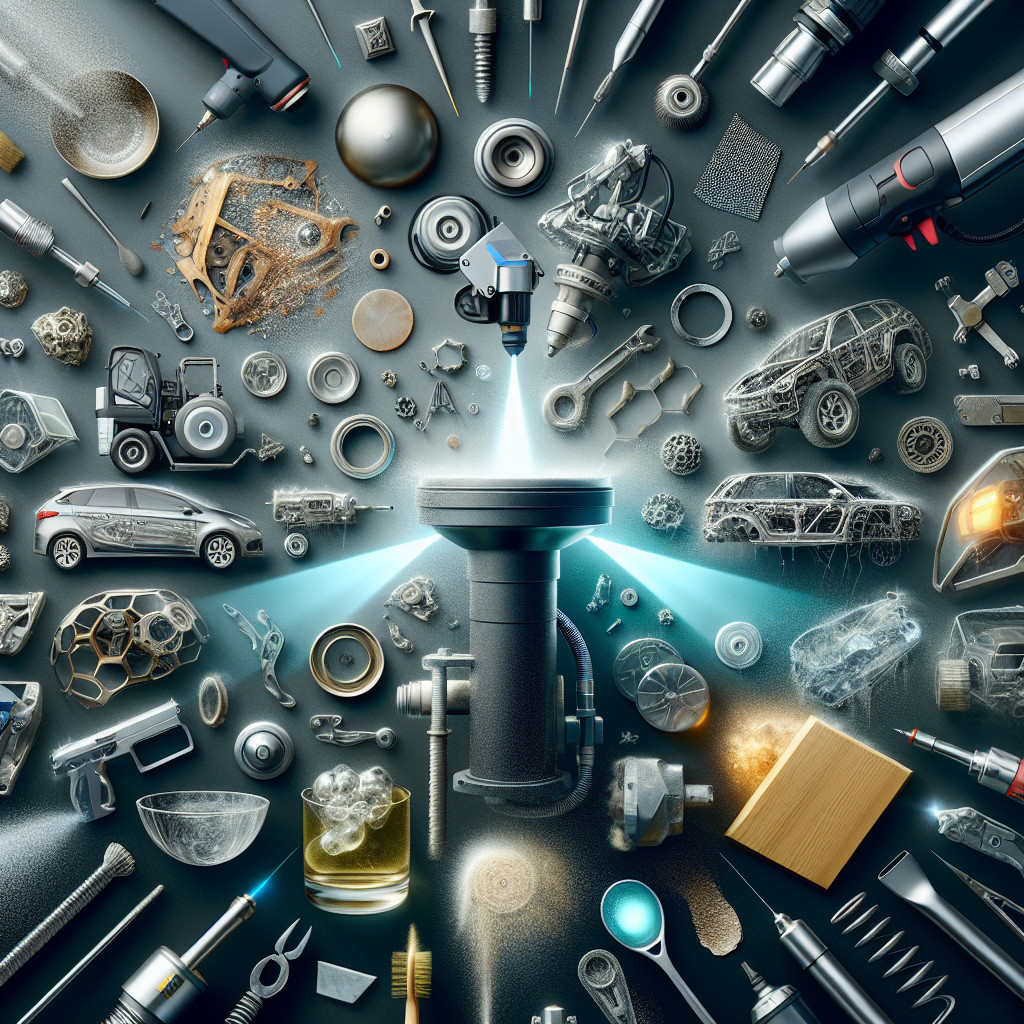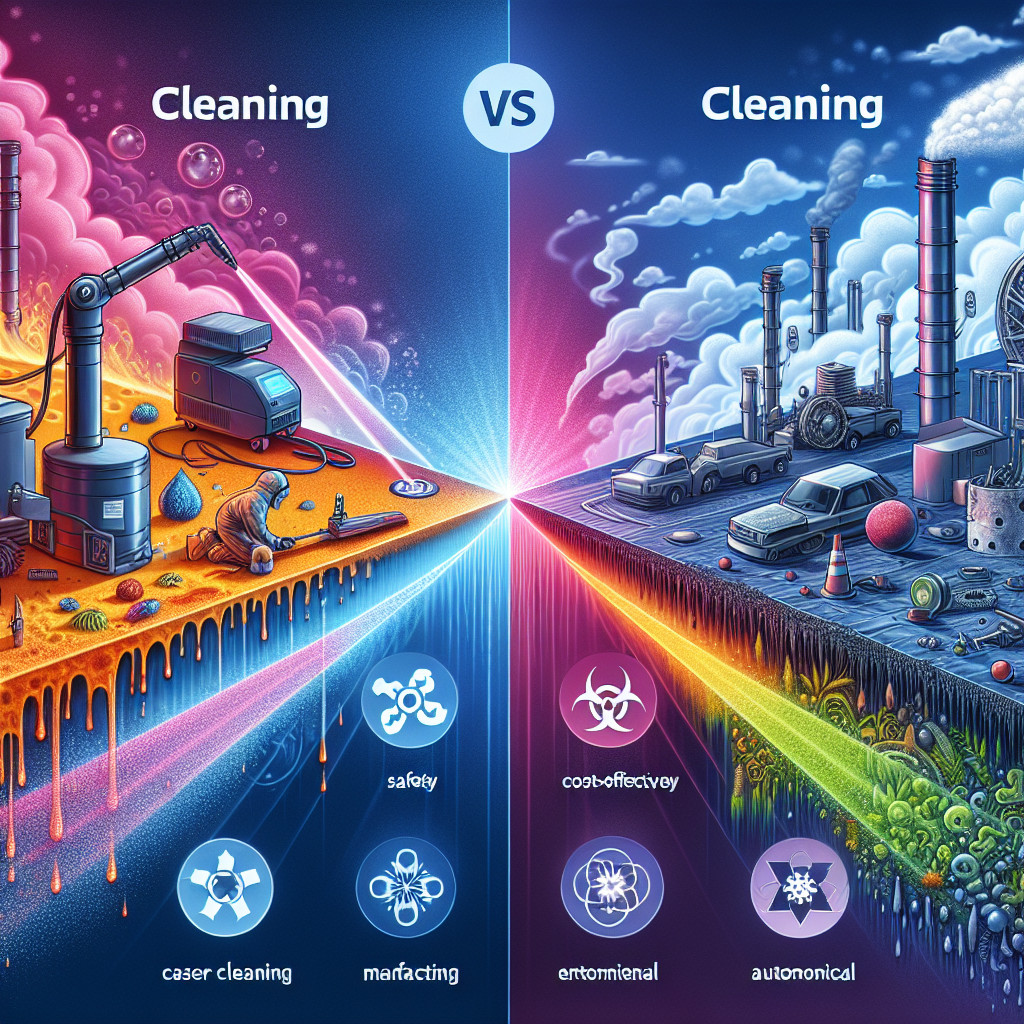- History and development of laser cleaning technology
- Overview of the food industry and its cleaning requirements
- Integration of laser cleaning into existing food processing lines
- Comparison of laser cleaning with other non-chemical cleaning methods in the food industry
- Use of laser cleaning in the removal of allergens from food processing equipment
- Use of laser cleaning in the removal of pesticides and chemical residues from food surfaces
- Role of laser cleaning in the removal of odors and flavors from food processing equipment
- Use of laser cleaning in the removal of foreign particles and contaminants from food surfaces
History and development of laser cleaning technology
Laser cleaning technology has revolutionized the field of surface cleaning and restoration. It offers a non-contact, non-abrasive, and highly precise method of removing contaminants, coatings, and impurities from various surfaces. This article aims to explore the , highlighting its key milestones and advancements over the years.
Early Beginnings:
The concept of using lasers for cleaning purposes can be traced back to the 1960s when the first laser was invented. However, it wasn’t until the 1980s that researchers began to explore the potential of lasers in the field of cleaning. Initially, lasers were primarily used for cutting and welding applications, but their ability to deliver high-energy pulses made them suitable for cleaning as well.
Emergence of Laser Cleaning:
In the early 1990s, laser cleaning technology started gaining traction as researchers and engineers recognized its potential in various industries. The first commercial laser cleaning systems were introduced, primarily targeting the aerospace and automotive sectors. These early systems utilized pulsed lasers to remove rust, paint, and other contaminants from metal surfaces.
Advancements in Laser Technology:
As laser technology continued to evolve, so did laser cleaning systems. The introduction of fiber lasers in the early 2000s brought significant improvements in terms of efficiency, reliability, and cost-effectiveness. Fiber lasers offered higher power output, better beam quality, and longer lifetimes compared to their predecessors, making them ideal for industrial cleaning applications.
Applications and Benefits:
Laser cleaning technology found widespread applications in industries such as automotive, aerospace, electronics, cultural heritage preservation, and more. It proved to be highly effective in removing rust, oxides, coatings, and even delicate contaminants from various surfaces. Laser cleaning offered several advantages over traditional cleaning methods, including reduced environmental impact, minimal surface damage, and increased precision.
Ongoing Research and Development:
The field of laser cleaning technology continues to evolve, with ongoing research and development efforts focused on further improving its capabilities. Researchers are exploring new laser sources, such as ultrafast lasers, which offer even higher precision and control. Additionally, advancements in beam delivery systems and automation have made laser cleaning more efficient and accessible to a wider range of industries.
Keywords: laser cleaning technology, surface cleaning, restoration, contaminants, coatings, impurities, milestones, advancements, non-contact, non-abrasive, precise, early beginnings, cutting, welding, high-energy pulses, emergence, commercial systems, aerospace, automotive, pulsed lasers, rust, paint, fiber lasers, efficiency, reliability, cost-effectiveness, beam quality, applications, benefits, environmental impact, ongoing research, ultrafast lasers, precision, control, beam delivery systems, automation.
Long-tail Phrases:
1. .
2. Advancements in laser technology for surface cleaning.
3. Applications and benefits of laser cleaning in various industries.
4. The emergence of laser cleaning in the aerospace and automotive sectors.
5. Ongoing research and development in laser cleaning technology.
6. The impact of laser cleaning on environmental sustainability.
7. Precision and control in laser cleaning processes.
8. Fiber lasers and their role in revolutionizing surface cleaning.
9. The effectiveness of laser cleaning in removing rust and coatings.
10. Automation and beam delivery systems in laser cleaning applications.
Overview of the food industry and its cleaning requirements
W przemyśle spożywczym istnieje wiele różnych obszarów, które wymagają regularnego czyszczenia. Przykładowo, linie produkcyjne, maszyny, urządzenia, powierzchnie robocze, podłogi, ściany, zbiorniki, rury i wiele innych elementów muszą być regularnie czyszczone, aby zapewnić bezpieczeństwo żywności. Często stosuje się specjalne środki czyszczące i dezynfekujące, które są skuteczne w eliminowaniu bakterii, wirusów i innych zanieczyszczeń.
Ważne jest również, aby personel odpowiedzialny za czyszczenie miał odpowiednie szkolenie i świadomość znaczenia czystości w przemyśle spożywczym. Muszą oni być świadomi różnych zagrożeń związanych z brakiem czystości i wiedzieć, jak prawidłowo stosować środki czyszczące i dezynfekujące. Ponadto, personel powinien być odpowiednio wyposażony w niezbędne narzędzia i sprzęt do czyszczenia.
W ostatnich latach przemysł spożywczy stał się bardziej świadomy wpływu swojej działalności na środowisko. W związku z tym, wiele firm wprowadza innowacyjne rozwiązania, które pozwalają na bardziej ekologiczne czyszczenie. Przykładowo, stosuje się biodegradowalne środki czyszczące i dezynfekujące, które są mniej szkodliwe dla środowiska. Ponadto, wiele firm inwestuje w technologie, które pozwalają na bardziej efektywne wykorzystanie wody i energii podczas procesów czyszczenia.
Ważne jest również, aby przemysł spożywczy przestrzegał odpowiednich przepisów i regulacji dotyczących czyszczenia. Wiele krajów ma specjalne przepisy dotyczące higieny i czystości w przemyśle spożywczym, które muszą być przestrzegane przez producentów żywności. Niewłaściwe czyszczenie może prowadzić do sankcji prawnych i utraty zaufania konsumentów.
Podsumowując, przemysł spożywczy jest sektorem o ogromnym znaczeniu dla gospodarki światowej. Wymaga on utrzymania wysokich standardów czystości i higieny, aby zapewnić bezpieczeństwo żywności. Czyszczenie jest nieodłącznym elementem tego sektora i obejmuje wiele różnych obszarów i procedur. Wprowadzanie innowacyjnych rozwiązań ekologicznych oraz przestrzeganie przepisów i regulacji są kluczowe dla utrzymania wysokich standardów czystości w przemyśle spożywczym.
Słowa kluczowe: przemysł spożywczy, czystość, higiena, bezpieczeństwo żywności, czyszczenie, dezynfekcja, linie produkcyjne, maszyny, środki czyszczące, personel, szkolenie, środowisko, przepisy, regulacje.
Frazy kluczowe: standardy czyszczenia w przemyśle spożywczym, procedury czyszczenia i dezynfekcji, wpływ czystości na jakość żywności, zagrożenia związane z brakiem czystości, ekologiczne rozwiązania czyszczenia, efektywne wykorzystanie wody i energii, przepisy dotyczące czyszczenia w przemyśle spożywczym.
Integration of laser cleaning into existing food processing lines
Laser cleaning is a non-contact, non-abrasive method of removing contaminants from surfaces. It utilizes a high-intensity laser beam to vaporize or ablate unwanted substances, leaving behind a clean surface. When integrated into food processing lines, laser cleaning offers several advantages. Firstly, it eliminates the need for manual cleaning, reducing labor costs and minimizing the risk of human error. Secondly, laser cleaning is a dry process, eliminating the use of water or chemicals, which can be harmful to the environment. Additionally, laser cleaning is highly precise, allowing for targeted cleaning of specific areas, ensuring thorough removal of contaminants.
Integration Process:
Integrating laser cleaning into existing food processing lines requires careful planning and consideration. The first step is to assess the current cleaning methods and identify areas where laser cleaning can be implemented. This involves evaluating the type and level of contaminants present, as well as the surface materials and geometry. Once the suitable areas are identified, the next step is to select the appropriate laser cleaning system. Factors such as power, wavelength, and pulse duration need to be considered to ensure optimal cleaning performance. The laser cleaning system is then integrated into the existing processing line, ensuring seamless operation and minimal disruption to production.
Applications in Food Processing:
Laser cleaning can be applied to various stages of the food processing line, including pre-processing, processing, and packaging. In pre-processing, laser cleaning can be used to remove dirt, debris, and other contaminants from raw materials, ensuring a clean and safe starting point. During processing, laser cleaning can be utilized to clean equipment surfaces, such as conveyor belts, cutting blades, and mixing tanks, preventing cross-contamination and maintaining hygiene standards. In packaging, laser cleaning can be employed to clean packaging materials, ensuring the integrity and safety of the final product.
Keywords: laser cleaning, food processing, integration, contaminants, cleanliness, productivity, efficiency, non-contact, non-abrasive, labor costs, environmental impact, precision, planning, implementation, surface materials, geometry, laser cleaning system, pre-processing, processing, packaging, raw materials, equipment surfaces, hygiene standards, packaging materials.
Long-tail phrases:
1. Integration of laser cleaning technology into existing food processing lines.
2. Benefits of laser cleaning in the food processing industry.
3. Implementation process of laser cleaning in food processing operations.
4. Applications of laser cleaning in pre-processing, processing, and packaging stages.
5. Impact of laser cleaning on cleanliness, productivity, and efficiency in food processing.
6. Environmental advantages of laser cleaning in the food industry.
7. Precision and targeted cleaning with laser technology in food processing.
8. Cost-saving potential of laser cleaning in labor-intensive cleaning processes.
9. Ensuring food safety through the integration of laser cleaning in processing lines.
10. Enhancing product quality and integrity with laser cleaning in food packaging.
In conclusion, the offers numerous benefits to the industry. It improves cleanliness, reduces downtime, enhances product quality, and increases productivity. By eliminating manual cleaning, minimizing environmental impact, and providing precise cleaning capabilities, laser cleaning technology proves to be a valuable addition to food processing operations. As the industry continues to evolve, the integration of laser cleaning is expected to become more widespread, ensuring safer and higher-quality food products for consumers.
Comparison of laser cleaning with other non-chemical cleaning methods in the food industry
Tradycyjne metody czyszczenia, takie jak mycie wodą, czyszczenie chemiczne i czyszczenie parowe, są powszechnie stosowane w przemyśle spożywczym. Jednakże, w ostatnich latach, coraz większą popularność zyskuje czyszczenie laserowe. Metoda ta wykorzystuje wiązkę lasera do usuwania zanieczyszczeń z powierzchni.
Czyszczenie laserowe oferuje wiele korzyści w porównaniu do tradycyjnych metod czyszczenia. Po pierwsze, jest to metoda niechemiczna, co oznacza, że nie są stosowane żadne substancje chemiczne, które mogą pozostawać na powierzchni produktów spożywczych. Jest to szczególnie istotne w przypadku produktów spożywczych, które są spożywane bezpośrednio, takich jak owoce i warzywa. Czyszczenie laserowe jest również bardziej ekologiczne, ponieważ nie generuje odpadów chemicznych.
Kolejną zaletą czyszczenia laserowego jest jego skuteczność. Laser jest w stanie usunąć nawet najtrudniejsze zanieczyszczenia, takie jak tłuszcz, olej czy resztki żywności. Wiązka lasera jest precyzyjna i skoncentrowana, co pozwala na dokładne czyszczenie powierzchni. Ponadto, czyszczenie laserowe jest szybkie i efektywne, co pozwala zaoszczędzić czas i koszty związane z czyszczeniem.
Inną zaletą czyszczenia laserowego jest jego wszechstronność. Metoda ta może być stosowana do czyszczenia różnych powierzchni, takich jak stal nierdzewna, aluminium, szkło czy tworzywa sztuczne. Może być również stosowana do czyszczenia różnych urządzeń i maszyn w przemyśle spożywczym, takich jak taśmy transportujące, zbiorniki czy maszyny pakujące.
Mimo wielu zalet, czyszczenie laserowe ma również pewne ograniczenia. Po pierwsze, jest to metoda kosztowna, zarówno jeśli chodzi o zakup urządzenia, jak i jego utrzymanie. Ponadto, czyszczenie laserowe może być bardziej skomplikowane niż tradycyjne metody czyszczenia i wymaga specjalistycznej wiedzy i umiejętności.
Wnioskiem jest to, że czyszczenie laserowe jest skuteczną i niechemiczną metodą czyszczenia, która może być stosowana w przemyśle spożywczym. Oferuje wiele korzyści, takich jak brak substancji chemicznych na powierzchni produktów spożywczych, skuteczność w usuwaniu zanieczyszczeń, wszechstronność i szybkość. Jednakże, należy również wziąć pod uwagę koszty i skomplikowanie tej metody.
Słowa kluczowe: czyszczenie laserowe, przemysł spożywczy, higiena, bezpieczeństwo żywności, tradycyjne metody czyszczenia, niechemiczne metody czyszczenia, skuteczność, ekologia, wszechstronność, koszty, specjalistyczna wiedza.
Frazy kluczowe: czyszczenie laserowe w przemyśle spożywczym, porównanie czyszczenia laserowego z tradycyjnymi metodami czyszczenia, zalety czyszczenia laserowego w przemyśle spożywczym, ograniczenia czyszczenia laserowego, skuteczność czyszczenia laserowego w usuwaniu zanieczyszczeń, ekologiczne czyszczenie laserowe, szybkie czyszczenie laserowe, wszechstronne czyszczenie laserowe, koszty czyszczenia laserowego, specjalistyczne czyszczenie laserowe.
Use of laser cleaning in the removal of allergens from food processing equipment
Laser cleaning is a non-contact, non-abrasive method that uses high-intensity laser beams to remove contaminants from surfaces. It works by delivering short pulses of laser energy, which vaporize the contaminants without damaging the underlying material. This technology has been widely used in various industries, including automotive, aerospace, and electronics, due to its precision and effectiveness. Now, it is being explored for its potential in the food industry, particularly in the removal of allergens from food processing equipment.
Benefits of Laser Cleaning in Food Processing:
1. Enhanced Cleaning Efficiency: Laser cleaning can reach areas that are difficult to access using traditional cleaning methods, such as crevices, corners, and intricate parts of equipment. This ensures a more thorough removal of allergens, reducing the risk of cross-contamination.
2. Non-Destructive: Unlike abrasive cleaning methods, laser cleaning does not cause any damage to the surface of the equipment. It selectively removes contaminants without altering the properties of the underlying material, ensuring the longevity of the equipment.
3. Chemical-Free: Laser cleaning eliminates the need for harsh chemicals, which are often used in traditional cleaning methods. This not only reduces the environmental impact but also eliminates the risk of chemical residues contaminating the food processing equipment.
4. Time and Cost Savings: Laser cleaning is a highly efficient process that requires minimal downtime. It eliminates the need for disassembling equipment for cleaning, reducing the overall cleaning time and labor costs.
Challenges and Considerations:
While laser cleaning shows great potential in the removal of allergens from food processing equipment, there are some challenges and considerations to be addressed:
1. Equipment Compatibility: Not all types of food processing equipment may be suitable for laser cleaning. Compatibility with different materials and surfaces needs to be evaluated to ensure the effectiveness of the cleaning process.
2. Safety Measures: Laser cleaning involves the use of high-intensity laser beams, which can pose a safety risk if not properly controlled. Adequate safety measures, such as protective eyewear and controlled laser settings, should be implemented to ensure the safety of operators and prevent accidents.
3. Validation and Regulations: The use of laser cleaning in the food industry requires validation and compliance with regulatory standards. Extensive testing and validation studies need to be conducted to ensure that laser cleaning effectively removes allergens and meets the necessary food safety regulations.
Conclusion:
Laser cleaning technology offers a promising solution for the removal of allergens from food processing equipment. Its non-destructive, chemical-free, and efficient nature makes it an attractive alternative to traditional cleaning methods. However, further research and development are needed to address the challenges and ensure the compatibility, safety, and regulatory compliance of laser cleaning in the food industry.
Keywords: laser cleaning, allergens, food processing equipment, cross-contamination, non-destructive, chemical-free, efficiency, compatibility, safety measures, validation, regulatory compliance.
Long-tail phrases:
– Laser cleaning technology for allergen removal in food processing equipment
– Benefits and challenges of laser cleaning in the food industry
– Non-abrasive cleaning methods for allergen-free food processing equipment
– Laser cleaning: a safe and efficient solution for allergen removal
– Enhancing food safety through laser cleaning of processing equipment.
Use of laser cleaning in the removal of pesticides and chemical residues from food surfaces
Laser cleaning involves the use of high-intensity laser beams to remove contaminants from surfaces. The laser beam targets the specific area of contamination, causing the residues to evaporate or break down into harmless byproducts. This process is highly precise and does not damage the underlying food surface. Laser cleaning can effectively remove various types of contaminants, including pesticides, herbicides, fungicides, and other chemical residues.
Advantages of Laser Cleaning:
1. Efficiency: Laser cleaning offers a highly efficient method of removing pesticides and chemical residues. The focused laser beam can target specific areas, ensuring thorough cleaning without wasting energy or resources.
2. Non-toxic: Unlike traditional cleaning methods that may require the use of harsh chemicals, laser cleaning is a non-toxic process. It does not introduce any additional chemicals or residues onto the food surface, making it a safe and environmentally friendly option.
3. Preservation of food quality: Laser cleaning does not alter the physical or chemical properties of the food surface. It does not affect the taste, texture, or nutritional value of the food, ensuring that the quality of the product remains intact.
4. Cost-effective: While the initial investment in laser cleaning equipment may be higher compared to traditional cleaning methods, the long-term cost benefits are significant. Laser cleaning eliminates the need for expensive chemical cleaning agents and reduces water consumption, resulting in cost savings for food manufacturers.
5. Time-saving: Laser cleaning is a rapid process that can be automated, allowing for high-speed cleaning of food surfaces. This saves time and increases productivity in food processing facilities.
Applications of Laser Cleaning in the Food Industry:
1. Fruit and vegetable cleaning: Laser cleaning can effectively remove pesticides and chemical residues from the surfaces of fruits and vegetables. This ensures that consumers can enjoy fresh produce without worrying about potential health risks.
2. Equipment cleaning: Laser cleaning can be used to clean food processing equipment, such as conveyor belts, cutting tools, and storage containers. This helps maintain hygiene standards and prevents cross-contamination in food production facilities.
3. Packaging materials: Laser cleaning can be applied to remove contaminants from packaging materials, such as plastic films or glass jars. This ensures that the packaging does not introduce any harmful substances into the food products.
4. Food contact surfaces: Laser cleaning can be used to clean food contact surfaces, such as countertops, cutting boards, and utensils. This helps prevent the transfer of pesticides and chemical residues from these surfaces to the food being prepared.
Conclusion:
Laser cleaning offers a promising solution for the removal of pesticides and chemical residues from food surfaces. Its efficiency, non-toxic nature, preservation of food quality, cost-effectiveness, and time-saving capabilities make it an attractive option for the food industry. By implementing laser cleaning technology, food manufacturers can ensure the safety and quality of their products, providing consumers with peace of mind. Further research and development in this field will continue to enhance the effectiveness and applicability of laser cleaning in the food industry.
Keywords: laser cleaning, pesticides, chemical residues, food surfaces, food safety, efficiency, non-toxic, preservation, cost-effective, time-saving, fruit and vegetable cleaning, equipment cleaning, packaging materials, food contact surfaces.
Long-tail phrases: removal of pesticides and chemical residues from food surfaces, laser cleaning in the food industry, benefits of laser cleaning, applications of laser cleaning in food processing, laser cleaning for food safety.
Role of laser cleaning in the removal of odors and flavors from food processing equipment
In the context of food processing equipment, laser cleaning offers several advantages over traditional cleaning methods. Firstly, it eliminates the need for harsh chemicals and detergents, which can leave residues and potentially contaminate the food. Laser cleaning is a dry process that does not require the use of water, making it more environmentally friendly and reducing the risk of bacterial growth.
Secondly, laser cleaning can reach areas that are difficult to access with conventional cleaning methods. Food processing equipment often has intricate designs and complex surfaces, making it challenging to remove all traces of odors and flavors. Laser beams can be precisely directed to target specific areas, ensuring thorough cleaning and odor removal.
Furthermore, laser cleaning is a fast and efficient process. It can remove contaminants from food processing equipment in a fraction of the time compared to traditional methods. This not only increases productivity but also reduces downtime for cleaning and maintenance.
Another significant advantage of laser cleaning is its ability to remove even the most stubborn odors and flavors. Traditional cleaning methods may only mask or temporarily eliminate these unwanted smells, but laser cleaning can effectively break down and remove the molecules responsible for the odor. This ensures that the food processing equipment is thoroughly cleaned and ready for the production of different food products without any residual flavors.
Moreover, laser cleaning is a safe and non-destructive method. It does not cause any physical damage to the equipment, preserving its structural integrity and prolonging its lifespan. This is particularly important in the food processing industry, where equipment is often expensive and requires regular maintenance to ensure optimal performance.
In conclusion, laser cleaning technology plays a crucial role in the removal of odors and flavors from food processing equipment. Its non-contact, non-abrasive, and precise nature make it an ideal solution for thoroughly cleaning complex surfaces and removing contaminants. By utilizing laser cleaning, food processing companies can ensure the production of safe and high-quality food products, free from any unwanted odors or flavors.
Keywords: laser cleaning, food processing equipment, odors, flavors, contaminants, cross-contamination, non-contact, non-abrasive, precision, environmentally friendly, bacterial growth, productivity, stubborn odors, safe, non-destructive, structural integrity, maintenance.
Long-tail phrases: laser cleaning technology in food processing, removal of odors and flavors from food processing equipment, non-contact and non-abrasive cleaning, environmentally friendly cleaning methods, laser cleaning for complex surfaces, laser cleaning for stubborn odors, safe and non-destructive cleaning, prolonging the lifespan of food processing equipment.
Use of laser cleaning in the removal of foreign particles and contaminants from food surfaces
Laser cleaning is a non-contact and non-abrasive cleaning method that utilizes laser beams to remove contaminants from surfaces. The laser beam is directed towards the contaminated area, and the energy from the laser causes the contaminants to vaporize or sublimate, leaving behind a clean surface. This technology offers several advantages over traditional cleaning methods, including precision, efficiency, and environmental friendliness.
Benefits of laser cleaning in the food industry:
1. Non-toxic and chemical-free: Laser cleaning does not require the use of chemical cleaning agents, reducing the risk of chemical residues on food surfaces. This makes it a safer and more environmentally friendly option for food cleaning.
2. Preservation of food quality: Laser cleaning is a gentle process that does not damage the underlying food surface. It can effectively remove contaminants without altering the texture, taste, or nutritional value of the food. This ensures that the quality of the food is maintained.
3. Increased efficiency: Laser cleaning is a fast and efficient method of removing contaminants. It can clean large areas in a short amount of time, reducing the cleaning time required in food processing facilities. This can lead to increased productivity and cost savings.
4. Versatility: Laser cleaning can be used on a wide range of food surfaces, including metal, plastic, glass, and ceramic. It can effectively remove various types of contaminants, such as dirt, grease, oils, and bacteria. This versatility makes it suitable for use in different food processing and packaging applications.
5. Reduced water consumption: Traditional cleaning methods often require the use of large amounts of water. Laser cleaning eliminates the need for excessive water usage, reducing water consumption and wastewater generation. This contributes to water conservation efforts and helps in achieving sustainability goals.
Challenges and considerations:
While laser cleaning offers numerous benefits, there are certain challenges and considerations that need to be addressed. These include:
1. Cost: Laser cleaning equipment can be expensive to purchase and maintain. However, the long-term cost savings from reduced chemical usage, water consumption, and increased productivity may outweigh the initial investment.
2. Safety precautions: Laser cleaning involves the use of high-intensity laser beams, which can be hazardous if not used properly. Adequate safety measures, such as protective eyewear and training, should be implemented to ensure the safety of workers.
3. Compatibility with different food surfaces: Laser cleaning may not be suitable for all types of food surfaces. Some surfaces may absorb or reflect laser energy, making the cleaning process less effective. Compatibility tests should be conducted to determine the suitability of laser cleaning for specific food surfaces.
Conclusion:
Laser cleaning technology has the potential to revolutionize the food industry by providing a safe, efficient, and environmentally friendly method for removing foreign particles and contaminants from food surfaces. Its non-toxic nature, preservation of food quality, increased efficiency, versatility, and reduced water consumption make it an attractive option for food processing and packaging applications. However, careful consideration of cost, safety precautions, and compatibility with different food surfaces is necessary before implementing laser cleaning in the food industry.
Keywords: laser cleaning, food safety, contaminants, foreign particles, non-toxic, chemical-free, preservation of food quality, efficiency, versatility, reduced water consumption, cost, safety precautions, compatibility.
Long-tail phrases: use of laser cleaning in food processing, benefits of laser cleaning in food industry, challenges of laser cleaning in food safety, laser cleaning technology for food surfaces, laser cleaning vs traditional cleaning methods.
- Laser cleaning and long-term cost savings – cost analysis - February 29, 2024
- Laser cleaning and reducing emissions of harmful substances - February 28, 2024
- Can laser cleaning be used in veterinary medicine? - February 28, 2024


























